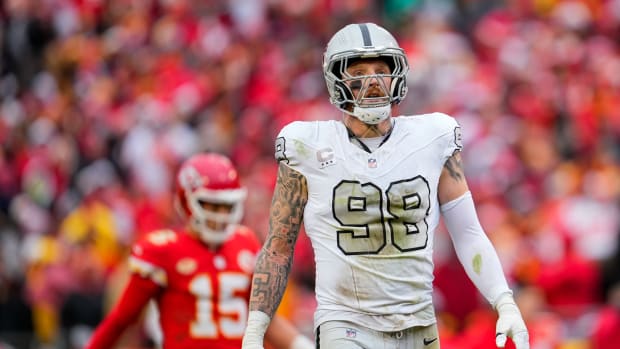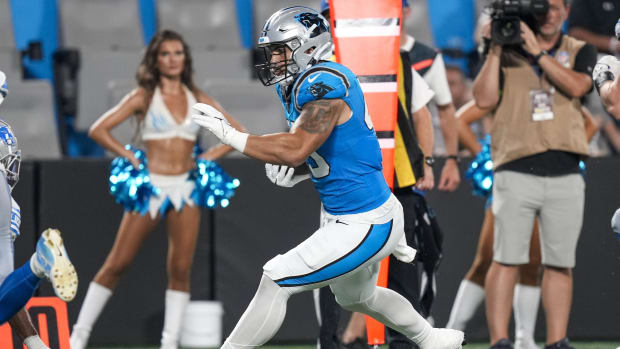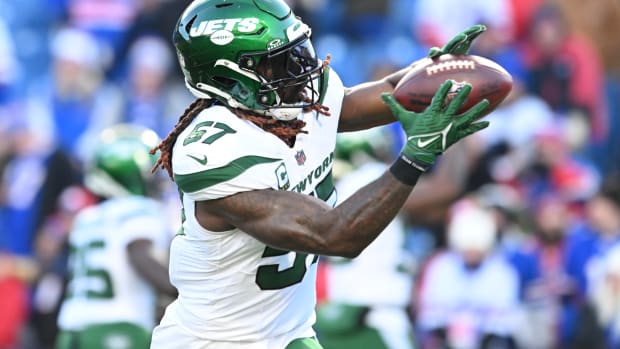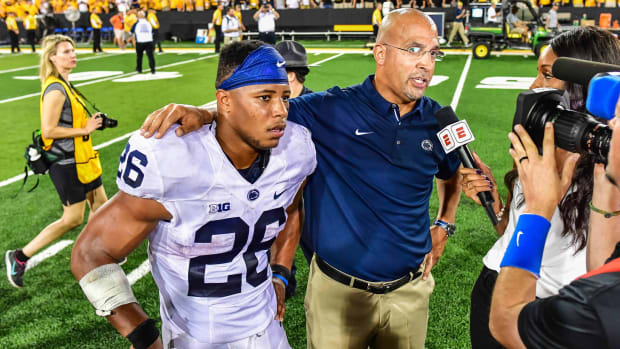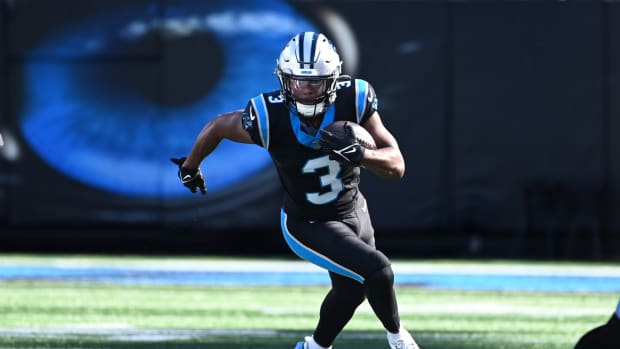Who is Aaron Rodgers? The many sides of the NFL's best quarterback
This story appears in the Sept. 21, 2015 issue of SPORTS ILLUSTRATED. To subscribe, click here.
You have reached your limit of 4 premium articles
Register your email to get 1 more
Before Mark Kelly appeared on Celebrity Jeopardy! in May, his twin brother, Scott, compiled a scouting report for him. From space. As in, low-earth orbit. As in, aboard NASA's International Space Station. It didn't take Scott long to conclude that his brother faced a formidable opponent. So he called Mark from about 250 miles above the earth and said, “Aaron Rodgers did better on his SATs than you did.”
Mark Kelly—astronaut, engineer, author and Navy captain—just laughed. He held no pretense about Rodgers, whose girlfriend, the actress Olivia Munn, had introduced the two men over drinks. At that point Kelly knew Rodgers only as the Packers' quarterback, Brett Favre's successor, Super Bowl champion and star of those Discount Double Check commercials. Then, Mark Kelly says, “he asked me about astrophysics.”
One off-season, for fun, Rodgers—thrower of touchdowns, seeker of truths—read Earthing, a book that explains how the physical disconnect between human beings and nature (mainly because of things like shoes and beds) contributes to inflammation, pain, fatigue, stress and poor sleep.
Or something. Teammates reacted as could reasonably be expected: Nerd alert.
Anyway, Rodgers, Kelly and Shark Tank star Kevin O'Leary arrived on set for a Jeopardy! practice run, which is basically the same as the televised show, minus host Alex Trebek. The results don't count, but Rodgers wanted to win. ... Actually, he didn't just want to win—he needed to win. He knew everything about the show's format, and so he clarified the rules when his opponents were unclear. The dry run confirmed Kelly's biggest threat: Who is Aaron Rodgers?
On the show, Rodgers dominated. He cruised through the “Number 12” category and conquered “Bible MVPs.” He threw only one game-show interception, on a Daily Double, citing Steve Wozniak as the cofounder of IBM rather than Apple. He won $50,000 for his charity, Midwest Athletes Against Childhood Cancer, and then retired, with Kelly and Munn, to dinner. That's where Kelly maintained, as he does now, that Rodgers's victory “came down to intelligence and reflexes,” an ability to process information and click the buzzer fastest—his explanation not unlike the film-room defense of a hapless cornerback who found himself on the wrong side of a Rodgers quick slant.
NFL Week 2 picks: Teams out to prove first impressions don't last long
Teammates can relate. They describe Rodgers, 31, as a history buff and conspiracy theorist, the guy who walks by debates and interrupts them, the quarterback who needed just two days to memorize a college playbook. Some people around him, like Packers coach Mike McCarthy, wonder if Rodgers has a photographic memory. He can recall specific plays from games in high school, down to the exact formation and result. Or remember a particular round of golf from years ago—like the one in which Green Bay fullback John Kuhn talked during Rodgers's backswing. Kuhn, one of Rodgers's best friends, is now the talk-during-the-backswing guy. (He also, according to Rodgers, cheats at cribbage.)
Rodgers has always been this way. At Pleasant Valley High in Chico, Calif., he would stop each morning in the fall at the classroom of his baseball coach, Ron Souza. The topic of conversation—the 49ers, the closest thing to a home team—never changed. Rodgers knew the disguises their opponents used, the blitzes, the offense's audibles, and he would diagram all of that from memory. He was 15. “Most of us are concrete learners,” says Souza. “Aaron's not. He sees something one time, and he can recognize it.”
Or, as Packers guard Josh Sitton puts it, “he's smart to the point where he's kind of annoying.”
As the Packers prepped for their 2015 opener against the Bears, their quarterback tried to remain normal. Normal being relative, of course. It's hard to be ordinary when you're dating a Hollywood actress and outsmarting a renowned astronaut and chasing both a second Super Bowl ring and the best quarterbacks in NFL history. But that's Rodgers. He wants to stand out and blend in.
Rodgers's final line on Sunday reflected an almost perfect afternoon, his performance typical—which is to say clinical, deadly, efficient. Rodgers attempted only 23 passes in a 31–23 victory, but he completed 18 throws for 189 yards and three TDs, with a passer rating of 140.5. That despite losing his best receiver, Jordy Nelson, to a torn ACL in August, and despite this being his first game under a new play-caller, coordinator Tom Clements. Rodgers did that with a little help from an old friend in a familiar jersey, number 89.
A free-agent departee from Green Bay in 2014, receiver James Jones returned on Sept. 7 after being released first by the Raiders and then, two weeks ago, by the Giants. Each time, Rodgers was one of the first people Jones texted. When last week Jones walked into the locker room he called home from '07 through '13, he received a hug from his old quarterback. “Welcome back,” Rodgers said.
Cut twice over summer, James Jones fits in right away in Packers return
That's all Rodgers needed to convey. Under his leadership, the Packers' offense has never relied on one dominant target. Nelson and Randall Cobb each caught 90-plus balls last year. Greg Jennings departed for Minnesota in 2013 with 425 receptions as a Packer—best of luck. Jones caught 73 balls for the Raiders last year—good for him. Green Bay doesn't stop. This offense is like a Wisconsin winter: It's coming. No exceptions. Bundle up. “New, old, big, tall.... You know he's throwing,” says Jones. “That makes your job easier. Just catch it.”
So there was Jones on Sunday, already in the receiver rotation six days into his return. He caught the Packers' first touchdown of the season, plus the one that put Green Bay ahead for good.
Afterward, as reporters crowded around Jones's space in the cramped Soldier Field locker room, there were so many microphones and cameras and bodies that Rodgers couldn't get to his bags, which sat behind the receiver. So Rodgers stood there with a towel draped around his waist, soaking it all in. Then he retreated toward the showers, allowing Jones his moment. Later, Rodgers entered his press conference wearing a leather jacket and jeans. His final statement provided a window into how his brain works: He knew that Sunday's victory brought Green Bay within one win (at 92-93-6) of tying up the all-time series between two of the NFL's longest rivals.
Even at the lectern, Rodgers still had all the answers.
• VRENTAS: James Jones already standing out once again in Green Bay
[pagebreak]
For Rodgers, the search—for knowledge, for insight, for the smallest advantage—never ends. That's why he called up Angelo Poli in February 2011, about two weeks after he was named MVP of Super Bowl XLV, when most of the NFL was retreating to the Caribbean.
Poli runs Whole Body Fitness in Chico, sharing office space with Rodgers's father, Ed, a chiropractor. The NFL Players Association was about to go on strike, and Rodgers sensed an opportunity. He wanted to use the downtime to improve his nutrition and posture. He also wanted six-pack abs.
Rodgers underwent testing for his metabolic profile, a breakdown of how he ate and ran and sat, and how all that impacted his performance. “That was the first time I really thought about how nutrition affected my workouts,” Rodgers says. “I knew it affected my energy and the way I looked in the mirror. But it also affects how you play.”
Rodgers was not like that in college. He still remembers Sundays during his sophomore year at Cal, when, with whatever cash he had left on his meal card, he bought a box of Lucky Charms and a carton of milk to survive until his card was replenished.
Given the way he prepares, Tom Brady won't be slowing down anytime soon
Poli put together a nutrition plan: six meals a day, all lean proteins (chicken, fish) and slow-burning carbohydrates (brown rice, sweet potatoes) and quality fats (olive oil, avocados). Rodgers started taking multivitamins. He stopped eating steaks and starches the night before games. He tried to contain his sweet tooth. He still does.
Rodgers needed challenges, Poli says, “like nobody I've ever worked with.” The trainer taped potato chips to the quarterback's heels, forcing him to remain on his toes during drills. He had Rodgers throw at a net affixed to a moving motorcycle in order to improve timing. He had him hurl footballs while running on a treadmill or perform footwork drills while tossing at a laser beam that Poli moved around. “Most athletes have good coordination,” Poli says. “But Aaron can manage, calculate and strategize multiple things at once.”
When word reached Chico that Rodgers would compete with Kelly on Jeopardy!, Poli and his wife had the same reaction: That poor astronaut.
The season after he started working with Poli, Rodgers won the first of his two MVP awards. (He won again last year.) But that didn't end his quest. He watched documentaries, like Food Matters, about nutrition. He sampled vegan restaurants and limited his coffee intake. He changed his sleep habits, aiming for at least eight hours a night. He tried P90X and Insanity workouts, and while once he figured he would retire in his mid-30s, he now says, "Nutrition and flexibility are things that will keep me playing at a high level into my 40s."
Then, two summers ago, when he was living in Hollywood, Rodgers visited Ryan Capretta at Proactive Sports Performance in Westlake Village. He breezed past the oversized tires near the entrance and the framed jerseys (Emmitt Smith, Dwight Freeney) on the wall. He came alone. “He sat down on a couch,” Capretta recalls, and “I thought he was a dad—one of the high school kids' parents. He didn't say anything. Eventually I'm like, Oh, that's Aaron Rodgers; I should go say hello.”
Together they added to Rodgers's regimen, incorporating yoga and Pilates and boxing. Rodgers ran sand dunes and traversed the famous Santa Monica stairs. Capretta had to pull Rodgers out of some drills; the QB wanted to lift with the linemen, run with the cornerbacks. “Physically, he was better than I thought,” says Capretta. “Just pure strength, agility and speed. He was hanging with a lot of the skill guys.”
This off-season Capretta wondered how the calf injury that had sabotaged Rodgers in last season's playoffs would impact their training. He eased Rodgers into some drills, like sprints, but, he says, “Aaron didn't want to limit anything.” They even teased each other about the injury.
Rodgers: “We need to incorporate more calf raises into the off-season program.”
Capretta: “We need to get more sessions in the gym than on the golf course.”
“It's all about the challenge,” says Rodgers. “Innovate and evolve and stay on top for a while. It can't be Groundhog Day. I can't be Bill Murray. I'd go as crazy as he did in that movie.”
Asked what else he did this off-season, Rodgers declines to elaborate. He's private like that.
“Can't say,” he says. Twice.
“I'll talk about it next year.”
It's late August, two days after the Packers lost Nelson for the season. Rodgers isn't happy, but there's little time to stew. Fans pack the bleachers at the practice field, grill brats in the nearby parking lots and pump Journey's ‘Don't Stop Believin'.’ Rodgers's number 12 jersey outnumbers all the others in the stands combined, and by a good margin. That's his name fans are screaming. That's his autograph they seek, his hand they want to touch.
MythBusters: Is it impossible to cover Rob Gronkowski?
It wasn't always like this. When Green Bay selected Rodgers in the first round of the 2005 draft, Favre was still the King of Wisconsin, the graybeard-folk-hero quarterback. Rodgers, says former teammate Ruvell Martin, “was a regular guy, just like everybody else.” Back then Rodgers could fly to receiver Terrence Murphy's wedding in the Virgin Islands and not worry about autograph requests. He could take one former coach, Butte (Calif.) College's Craig Rigsbee, to the Red Robin in Green Bay for dinner and not be noticed. His fellow rookies, Murphy says, teased Rodgers about his shoes. Murphy can't remember what kind they were, just that they were so ... normal. “We didn't do anything except for Red Robin and the movies,” says Murphy. “We were boring.”
Rigsbee returned to Green Bay in 2009, Rodgers's first Pro Bowl season, and the QB told him, “I can't do anything. I can't go anywhere.” They tried to eat out anyway. A woman in a Packers jersey approached Rodgers and bowed. “You're making me uncomfortable,” Rigsbee says Rodgers told her.
As Rodgers progressed from backup to starter to star to, arguably, the single best player in the league, friends say he tried to manage how much of himself he revealed to the public. It wasn't easy. On one hand: appearances, fame, the thousands of times he scribbled his name on everything from jerseys to body parts—that was all part of the gig. On the other: Rodgers never wanted the kind of attention that suffocates celebrities.
Back in Green Bay, practice ends and Rodgers settles at his locker for an interview. He doesn't want his family to participate in an SI story, doesn't want writers poking around Chico and doesn't want Munn (who hilariously told Conan O'Brien that she mistook Rodgers for a college football player the first time they met) to be interviewed. Rodgers carries a bin of mail but sets it carefully aside so as not to reveal its contents. Everything about his interaction with a reporter is calculated. He says he wants his teammates to see him conduct interviews the same way they do. He's one of them, he says. One of 53.
Those teammates say it's revealing the way Rodgers comports himself, revealing in how little he reveals. He's among the NFL's highest-paid quarterbacks (five years, $110 million) but not one of sports' top endorsers. (He ranked 27th, according to Opendorse.com, among athletes in 2014.) He doesn't have an entourage, an extensive car collection or a history of outrageous quotes. (When he told Packers fans to “relax” after a poor start last season, that was considered vocal.) “I don't think he's afraid of the spotlight,” says Packers general manager Ted Thompson. “But he doesn't crave it.”
Among the players Rodgers rolls with, his crew includes Green Bay's fullback (Kuhn), long snapper (Brett Goode) and a backup linebacker from the Democratic Republic of the Congo (Andy Mulumba). Rodgers studies the Packers' rookies, where they came from. He knows everyone's birthday. He teases Goode for being image conscious when Goode changes his hairstyle or trims his beard.
When Mulumba met Rodgers, in 2013, the linebacker's hands shook as he introduced himself. But he noticed that Rodgers was wearing a T-shirt touting the Enough Project, a D.C. nonprofit that fights genocide and crimes against humanity in the Congo, and afterward Rodgers visited Mulumba's apartment to meet his parents. Over chicken and plantains Rodgers asked a million questions. Later he invited Mulumba to a birthday dinner at his house. Munn, Mulumba says, cooked rice, beef and green beans. His review: delicious.
Blanket Coverage: Why Grigson should be on the hot seat with Pagano
That's also Rodgers, football's all-inclusive quarterback. Broncos linebacker Von Miller works out with Capretta in the off-season, and after sessions, groups of players stop at a gas station down the street. “The attendant in there loves Aaron,” says Miller. “It's like he works there. Like he's one of the employees.”
Exposing enough of himself not to seem reclusive, being both one of the guys and the boss—on this Rodgers says, “Hopefully normal means relatable. There's no formula for it.” His answer reveals little.
Rodgers keeps in contact with a small circle of friends from high school. He tells teammates he likes to vacation outside the U.S. because he can walk around unnoticed. He controls what he can. And yet he's more open in person than expected. He's personable, sarcastic, funny, quick with specifics and anecdotes, heavy on eye contact. Basically, a normal dude.
“Hey,” says linebacker Clay Matthews, “why don't you just put chosen one on the story and put it out there.” He laughs. “Oh, right. That was Russell Wilson in Rolling Stone.”
The implication hangs there: That's not how Rodgers operates.
Even the most competitive people in an industry as ruthless as pro football find that Rodgers—how desperately he wants to win, how seriously he hates to lose—can be a little much. Like the time he played basketball against Matthews and his brothers at the Pro Bowl and, after losing, punted the ball so far that, Matthews quips, “we couldn't even find it. Lost in the Florida sun.”
“Aaron wants to step on your throat,” says Matthews, who (seemingly) means this as a compliment.
There was also the time, seven years ago, when Martin and Rodgers traveled around Alaska, meeting with troops and discussing their Christian faith. They were in the gym, and a few kids around age 15 challenged them to a game of basketball. This was before Rodgers was a starter; the teenagers had no idea who he was. One of the kids blocked Rodgers's shot, then swatted away a second attempt. Martin could see the frustration building in Rodgers, who then backed down the teenager, elbowed his way inside and scored. “We're dying laughing,” says Martin. “We're like: Aaron, come on, man.”
Finally content in retirement, Favre preps for his next Lambeau moment
So many stories go like this. The time the Packers played dodgeball and Rodgers pelted teammates without mercy. The time he played a charity event with pro golfer Jerry Kelly and insisted they keep score. The golf clubs he has tossed. The card tables he has slammed. The QB competitions—who can come closest to the pylon, who can hit the goalpost, who knows the most about Eastern European geography.
Rodgers spent three seasons behind Favre, from 2005 through '07, and lit up the starting D in Saturday walkthroughs, throwing no-look passes and deep TDs when defenders wanted nothing but to rest their legs. He celebrated afterward, even when his coach at the time, Mike Sherman, sent word for him to tone it down.
Meanwhile, Rodgers never misses an opportunity to remind someone, anyone, of a slight. He kept all his rejection letters from college. He reminds McCarthy in some way every season that the coach, then with the 49ers, drafted Alex Smith (now with the Chiefs) ahead of him in 2005. “We play Kansas City in Week 3,” says McCarthy. “We won't make it through the first half of that week without him saying something. I'm certain.”
Sensitive is a word that teammates often use to describe Rodgers. Sensitive about his height, 6'2". Sensitive about his circuitous path to the pros (even if it might not seem that circuitous to others). These teammates are sensitive, even, in describing their QB's sensitivity, because that in and of itself is a sensitive matter. “He pays attention to everything,” says Jennings, now with the Dolphins. “He remembers, and he's going to burn you. And when the microphone is on, he's going to subtly share some facetious statement that lets you know that he knows what you said and that he got the best of it.”
“No examples,” says Packers tackle Bryan Bulaga. “If he did forget, there's no need to remind him.”
“Sometimes,” Jennings says, “it's like: Aaron, come on, man. He holds on to things longer than you would hope. He definitely has the mind-set of being slighted. He may have to look in the mirror and say, Maybe everybody isn't [slighting] me anymore.”
[pagebreak]
The basics of Rodgers's story are so worn that they form something of an origin myth. Zero Division I scholarship offers out of high school; one year at Butte, a community college; then a chance encounter with Cal coach Jeff Tedford, who was recruiting a tight end and spotted a skinny QB with a big arm instead. “Pretty crazy,” Tedford says of that chance run-in. “He might go down as the best quarterback in the history of football.”
Then, the 2005 draft. Thompson monitored which teams needed QBs, and when the 49ers took Smith with the first pick, he thought Rodgers might slide all the way to Green Bay at No. 24. As Rodgers tumbled, Thompson felt like a pitcher late in a no-hitter: His scouts kept looking at him, but he wouldn't say whom he wanted. After 23 picks he finally informed Sherman of the plan: Rodgers. Rigsbee sent Rodgers a text message. “Best thing that ever happened to you.”
He was right. The Packers helped Rodgers correct a minor hitch in his throwing motion—he held the ball too high, above his ear, according to former Packers QB Don Majkowski. The rest is legend: the Dallas game in 2007 when Rodgers relieved an injured Favre and threw for 201 yards; Favre's first retirement, in March '08; Favre's first un-retirement, four months later; Favre's trade to the Jets that August; the fans that booed Rodgers and chanted, “We want Brett!” Mark Murphy, the Packers' president then and now, says Rodgers stepped into “a situation as difficult as any in league history.”
Rodgers at first focused on building relationships with his teammates. He hosted catered dinners at his house each Wednesday with different themes—Mexican one week, Italian the next, barbecue after that. “I wanted guys to know I was available,” he says.
The Packers finished 6–10 in 2008, Rodgers's first season at the helm, but they've made the playoffs every year since, including four straight division titles. “It's been amazing to watch the transformation in this locker room,” says Rodgers, “because there was a time when it was not as connected. Where guys didn't hang out. Guys didn't enjoy each other's company. When that changed, we started to believe we're going to win every game.”
The Packers won the Super Bowl following the 2010 season. They went 15–1 the next year but were upset in the divisional playoff round. They fell in the NFC title game last season, but only after a miraculous Seahawks comeback. That's three times in five years where they were thisclose to a championship. In the NFL, that's as consistent as it gets. And that's Rodgers: consistent. In the second game of that Super Bowl season, against the Falcons, Rodgers completed 31 of 36 passes and threw three TDs, zero INTs. The Packers prevailed 48–21. “He was perfect that day,” says Majkowski. “And he's pretty much been that way ever since.”
Everyone agrees on one thing about Rodgers that can never be described as normal: his skill set. Packers quarterback coach Alex Van Pelt jokes that his primary job is to make sure Rodgers wakes up on game day. “It's the toughest position in sports to play," says Tedford. “He makes it look easy. So effortless. So in control.”
The All-22: Six throws that display Marcus Mariota's quick NFL transition
There isn't one specific thing that most separates Rodgers from his peers; rather, it's the totality of his talents. McCarthy breaks it down thusly: Rodgers can throw from the pocket and on the run; with his feet set or moving; and on short, intermediate and long drops. There's no pass he can't make, no window too small, no defense too confusing. In recent seasons he's become more careful; of his five interceptions last year, four hit his receivers in the hands. “He doesn't throw picks,” says McCarthy. “There are reasons why.”
For Joe Whitt Jr., Green Bay's defensive backs coach, those reasons include Rodgers's ability to control defenders with his eyes. He makes more no-look passes than most NBA point guards. For free-agent QB Matt Blanchard—who spent this summer with the Packers—it's about Rodgers's footwork (his mother, Darla, was a dancer), the plays he extends, the way he's never off balance. For Clements, the coordinator, it's Rodgers's rapid-fire release. “He's a classic thrower,” says McCarthy. “Long arms, big hands, flawless mechanics.”
They could all go on. And they do. What's most telling is the number of teammates—10, roughly—who admit they steal glances at the jumbotron to catch Rodgers's highlights in real time. They're still surprised by the QB, despite the MVPs and the volume of eye-popping statistics. Clements says Rodgers wows him at least once a day. “You get bored,” he says. “Well, not bored, but you get used to him making throws you've never seen before.”
Teammates watched this summer with increasing amusement and wonder as Munn posted a series of Instagram videos costarring Rodgers. The couple swung swords, lip-synced to Mariah Carey and Boyz II Men, and reenacted dialogue from The Princess Bride. This was the Rodgers friends have always known, suddenly available for public consumption. “I just shook my head,” says Matthews. “Not what I expected.”
Some Packers think the videos speak to another step in Rodgers's evolution. Tackle David Bakhtiari points out that Rodgers became more vocal in his leadership last season. He seemed more comfortable in his interactions with the entire locker room.
Teammates think all of that speaks to a growing public comfort level for Rodgers. They think it's fair to speculate about the root of that—and they think it is Munn. “She's a big influence in his life,” says Cobb.
Then again, the Packers can never be exactly sure how comfortable their quarterback is. “If you ask him, everything is bugged,” says Kuhn. “Everybody's out to get him. But you can never tell when he's serious or when he's joking. He could be messing with us. We'd never know.”
What matters, what has always mattered, is bringing another title to Titletown. Rodgers hasn't talked much about the NFC championship game disaster against Seattle, the 12-point lead that evaporated in barely two minutes of the fourth quarter, the calf injury that impacted his ability to move. He won't make excuses now. But of course it stung. And of course he believes the Packers would have won if he was healthy. He's just not going to say that.
But now you can add that defeat to what drives Rodgers. “Right now he's arguably the best quarterback in the NFL, but he's not arguably the best ever,” says Matthews. “He's well on his way. But we need to get back and finish this time. And whether I like to admit it or not, this is an offensive team. It starts with him.”
Souza, his old high school coach, watches Rodgers and can still tell by his facial expressions exactly what he's thinking. “No facade,” Souza says. “No phony. He's still a country bumpkin.” Which brings Souza to his favorite Rodgers story. Just before the 2005 draft an NFL GM—he won't say which—called. The GM started pushing: What's the story? Drugs? Alcohol? Booze? Family? None of the above, Souza answered. But the GM pushed some more. “Guys like this don't fall out of the sky,” Souza recalls him saying.
Just ask the astronaut, who spent a fair amount of time up there. Mark Kelly can attest to Rodgers's best skill, his greatest contradiction: He stands out while he blends in. Everyone knows how good Rodgers is. What they don't know is how he got that way. That's the trick, the magician's sleight of hand. Rodgers is normal.... Until he isn't.

































